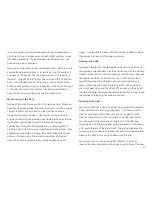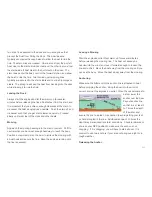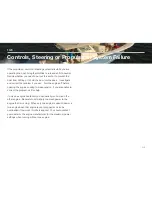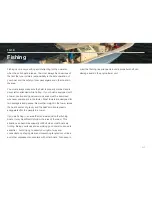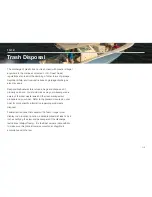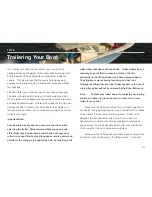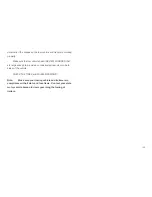
two stern lines secured to the dock and two spring lines that
prevent the boat from hitting the dock. The bow lines are
typically secured with enough slack to allow the boat to ride the
tide. The stern lines are crossed. One line runs from the port aft
boat cleat to the starboard dock cleat and the other line runs from
the starboard aft boat cleat to the port cleat on the dock. The
stern lines center the boat, control the forward motion, and allow
the boat to ride the tide. Two forward quarter spring lines
typically are secured to the stern cleats and to mid ship pilings or
cleats. The spring lines keep the boat from backing into the dock
while allowing it to ride the tide.
Leaving the Dock
Always start the engines and let them warm up for several
minutes before releasing the lines. Boats steer from the stern and
it is important that you achieve enough clearance at the stern to
maneuver the boat as quickly as possible. Push the stern o
ff
and
maneuver such that you get stern clearance quickly. Proceed
slowly until well clear of the dock and other boats.
Mooring
Approach the mooring heading into the wind or current. Shift to
neutral when you have just enough headway to reach the buoy.
Position a crew member on the bow to retrieve the mooring with
a boat hook and secure the line. Keep the engines running until
the line is secured.
Leaving a Mooring
Start the engines and let them warm up for several minutes
before releasing the mooring line. The boat will already be
headed into the wind, so move it forward enough to loosen the
line and untie it. Back the boat away from the mooring until you
can see the buoy. Move the boat slowly away from the mooring.
Anchoring
Make sure the bitter end of the anchor line is attached to boat
before dropping the anchor. Bring the bow into the wind or
current and put the engines in neutral. When the vessel comes to
a stop, lower the
anchor over the bow.
Pay out anchor line
so that it is at least 5
to 7 times the depth
of the water and
secure the line to a cleat. Use caution to avoid getting your feet
or hands tangled in the line. Additional scope of 10 times the
depth may be required for storm conditions. Check landmarks on
shore or your GPS position to make sure the anchor is not
dragging. If it is dragging, you will have to start all over. It is
prudent to use two anchors if your are anchoring overnight or in
rough weather.
Releasing the Anchor
111
Summary of Contents for 320 LXF
Page 1: ...320 LXF Scout Boats OWNER MANUAL ...
Page 2: ...Chapter 1 Owner s Information Warranty Certification and Boat Information ...
Page 11: ...Chapter 2 Propulsion A guide to your boat s propulsion system ...
Page 32: ...Chapter 4 Fuel System An overview of the fuel system of your boat ...
Page 40: ...Chapter 5 Electrical System An overview of the electrical system of your boat ...
Page 54: ...Chapter 6 Fresh Water System An overview of the fresh water system of your boat ...
Page 59: ...Chapter 7 Raw Water System An overview of the raw water system of your boat ...
Page 65: ...Chapter 8 Drainage System An overview of the drainage system of your boat ...
Page 70: ...Chapter 9 Ventilation System An overview of the ventilation system of your boat ...
Page 73: ...Chapter 10 Exterior Equipment An overview of the exterior equipment on your boat ...
Page 83: ...Chapter 11 Interior Equipment An overview of the interior equipment on your boat ...
Page 88: ...Chapter 12 Safety Equipment An overview of the safety equipment on your boat ...
Page 99: ...Chapter 13 Operation A general guide to operating your boat ...
Page 124: ...Chapter 14 Routine Maintenance A guide to keeping your boat running in good condition ...
Page 147: ...Chapter 16 Appendix Reference documents logs and schematics for your boat ...
Page 154: ...153 ...
Page 155: ...154 ...
Page 156: ...155 ...
Page 157: ...156 ...
Page 159: ...158 ...
Page 160: ...159 ...
Page 162: ...161 ...














